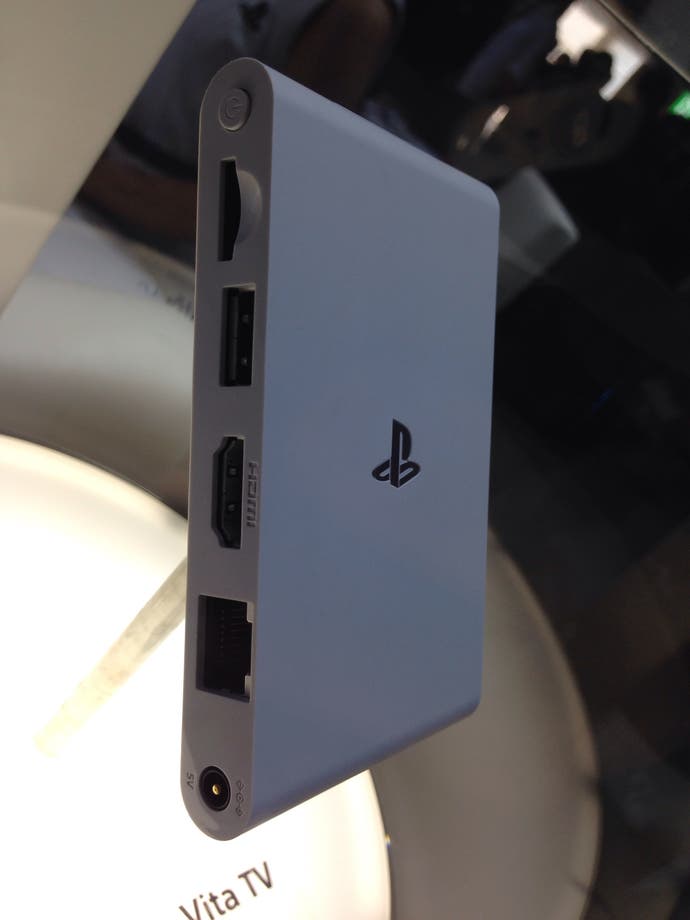Vita TV to take a "different road to market" in the west
Sony explains why it launched in Japan first.
Vita TV got off to a slow start in Japan - but that hasn't put Sony off of releasing it in the west.
The PlayStation micro-console launched in Japan on 14th November and sold a modest 42,000 units during launch week.
But according to Sony Computer Entertainment boss Andrew House, PlayStation's plan for Vita TV in the west remain unaffected.
"The positioning of Vita TV may be different between Japan and some of the other markets," he told Eurogamer.
Currently, the roughly $99 Vita TV reworks Vita, PSP, PSone and some retro games so they can be played on a HDTV with a DualShock 3 controller. The tiny machine is based on the Vita handheld console, with its touch-based user interface re-sized for big screens.
But it's also a media streaming device, and can extent PlayStation 4 gaming to a second screen when used with a DualShock 4.
House said Sony wanted to launch Vita TV in Japan first because there streaming is a relatively new concept, and the company wanted to establish a market.
"This may sound slightly counter-intuitive, but we wanted to launch in Japan first because I feel there really hasn't been a critical driver or device that's driven the adoption of streaming content overall," House said.
"It's still very much in a nascent stage in Japan compared to some of the markets in Europe or the US.
"We felt there was therefore an opportunity to leverage the strengths of PlayStation Vita, which as you know is quite strong in Japan in terms of game line-up, but combine that with the features of a media streaming box, and offer something packaged newly for the Japanese consumer and possibly be at the forefront of creating a new market via that device."

In the west, however, streaming has established itself, with the likes of Netflix and, on the gaming side, Gaikai and OnLive gaining a foothold in North America and Europe.
"It's a very different landscape when you look at the US and Europe - much greater establishment of streaming video services, and much greater understanding of what that concept's all about," House added.
"So we see strong market potential elsewhere in the world, but it will be a different road to market for the US and Europe than has been the case in Japan."
In Japan Sony is selling a Value Pack that bundles a Vita TV, a DualShock 3, an 8GB memory card and three months of PlayStation Plus for $150, but if you buy Vita TV on its own you get a limited out-of-box experience - you need a DualShock 3 controller to use it - and it only features 1GB of storage, so many are forced to buy Sony's expensive proprietary Vita memory cards to add space.
One problem already encountered in Japan is that the selection of Vita games to play on Vita TV is limited. Many, such as Uncharted: Golden Abyss, don't work because of Vita TV's lack of touch controls.
Sony may be waiting for its studios to add Vita TV compatibility to their games before launching Vita TV in the west, but it may also be waiting for its Gaikai game streaming service to launch before releasing it on these shores. Through Gaikai, due out in North America in 2014 with other territories to follow, the PS4 and Vita will be able to stream PlayStation 3 games - and it seems inevitable that Vita TV will also gain that functionality.
House hinted as much to Eurogamer in a recent interview.
"Our goal is to be able to have a new form of game distribution streamed from the server side, initially to PS4 consoles then gradually moving that out to Vita," House said.
"But eventually, the end game is to have this available on a multitude of network connected devices, essentially delivering a console quality gaming experience on devices which are not innately capable of doing that.
"We think there's a great opportunity to broaden the market, because you essentially remove the need to make the console purchase in order to have access to that experience. It may sound counter intuitive, because, aren't you replacing a business that is your bread and butter? But part of being an innovative company is being a pioneer in new forms of distribution of content, and we would like to be there first and take a leadership role."








